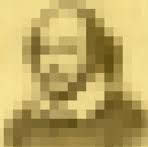 Images on a computer screen are made up of pixels. The pixels are made up into a 2d grid. The easiest way is to think of pixels is as little colored squares stacked together. Each square has its own 'address' and properties (colour and brightness). The more pixels per square inch the finer the detail on the image.
Images on a computer screen are made up of pixels. The pixels are made up into a 2d grid. The easiest way is to think of pixels is as little colored squares stacked together. Each square has its own 'address' and properties (colour and brightness). The more pixels per square inch the finer the detail on the image.
The computer speaks 'binary'. Binary is a code with only two states - high and low - 1 or 0 - it is ideal for communication within any electrical system. Each '1' or '0' in the code is called a 'bit' and eight bits make a byte. The number 11111111 in binary is 255 in decimal. Therefore using eight bits you can make 256 different binary numbers (if you include 00000000).
Depending on the number of 'bits' used for every pixel, the image can be displayed in lots of colours (True color) or limited to 256 colours. For instance, 8 bits per pixel can create an image with up to 256 colors. At 16 or 24 bits, a pixel can carry tens of millions of different colors. Not all the formats use the same number of bits.
| JPG |
JPEG is probably the most commonly used image format. Its name derives from the name of the people who developed the JPEG compression technique: the Joint Photographic Experts Group. Common file extensions associated with this format are .jpg, .jpeg. Jpeg is a good format for photographs because it offers a reasonable compromise between picture size and picture quality. However, images can lose their quality when repeatedly edited and saved in this format. It is not recommended for scanned documents or text that's going to be used with OCR software because of the digital artifacts (unpleasant visual defects in an image). |
|
| GIF |
GIF is the abbreviation for Graphics Interchange Format. The images saved in this format lose a lot of color information by being reduced to 256 colors (8 bits per pixel). That makes it not such a good format for photographs and large images but ideal for storing graphics with a limited number of colors such as clip art, simple drawings, logos, text, diagrams, icons, small images or pictures in greyscale. The great advantage of this format and what makes it so loved especially among the Internet users is the fact that it supports animation and transparency. That's why it is still largely used on the world wide web to create special effects and give life to web pages |
- supports transparency and animation
- only 256 colours
|
| PNG |
PNG (Portable Network Graphics) was created as a free and better alternative to GIF. This format supports animation and transparency, too, but is no longer limited to 256 colors. It has the advantage of truecolor (16 million colors). It can be used for editing photographs, since it doesn't lose quality through repeated savings like JPEG. However, JPEG is still preferred for transferring and distributing photos because of the reasonable file size. A disadvantage of PNG is that some of the Internet browsers do not support this format yet. |
- supports transparency and animation
- truecolor
|
| BMP |
BMP, also called Windows bitmap, is a format specific to the Windows operating system. It can be used in various Window-based applications but its great disadvantage is the large file size, since it doesn't use any compression. The 24 bits-per-pixel BMP files are great quality images but they take a lot of space. |
- big size!
- don't use on the web!
|
| TIFF |
TIFF (Tagged Image File Format) is recognized after the extensions .tif or .tiff. It is recommended especially for text and black and white images. Though it is not widely supported by web browsers, it remains the standard format for printing, scanned documents and Optical Character Recognition, since it doesn't have any of the JPG artifacts. |
- best option for scanned text
|

 Images on a computer screen are made up of pixels.
Images on a computer screen are made up of pixels. 
